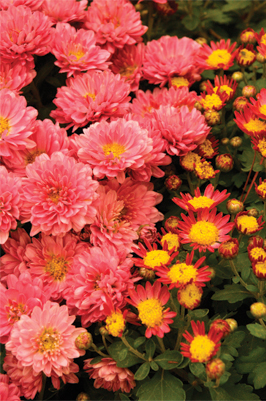One sure thing about the heat of midsummer is that it can really take the life out of flowering annuals. Many plants in splendid bloom in the spring and early summer are now becoming but dried remnants of their former selves.
Fortunately, there are plantings that can rejuvenate the color in your landscape, and one plant in particular, the garden mum (or “chrysanthemum” for those of you who like a lot a syllables) can really add flash to the landscape in the summer and well into the fall.
The idea of using mums for outdoor color is not exactly new. In fact, these flowers were known to have been grown in China 2,500 years ago. Even Confucius mentioned these beauties in his writings.
Although there are species of chrysanthemums native to Europe and North America, the predecessors of the cultivated varieties modern gardeners are familiar with actually didn’t appear in Europe until 1789 when merchants began importing the fancy flowers from the Orient.
The name chrysanthemum is derived from Greek for “golden flower.” It was originally the name of a native European mum that was also called the corn marigold. After the appearance of the brightly colored Oriental introductions though, the name was shifted to the new arrivals.
“Variety” is probably the best adjective for today’s mums. The plants themselves can be tall (excellent for cut flowers), medium (for potted plantings) or short (for borders). The flowers come in many shapes, and their colors — well, the next time you peek into a kaleidoscope, you will get the idea of the range — almost every hue except blue.
Soon, it will be prime time to buy mums for floral fireworks in your landscape. Most lawn and garden centers should have a pretty good supply of these beauties in bloom or almost flowering before summer begrudgingly gives way to autumn.
Some gardeners will tell you that these plants should be pinched back in late July or early August for best flower production, but this only applies to established plants, as most nurseries have already done this to their mums, and the flower buds are already developed. So if you pinch back newly store-bought plants, it’s the same as tossing away unopened blossoms.
Mums need at least four to five hours of sunlight, so if you have such a sunny spot, think about christening it with chrysanthemums. If they are not going to remain potted, mums should be planted in a site that is well-draining, as the roots will rot in soggy soil. In addition, the bed should be well amended with organic material, because these plants are heavy feeders. Even after planting mums in such lush growing ground, for full flower power, add diluted liquid fertilizer around the plants every two weeks. And deadheading spent blossoms will encourage reblooming.
With heat and dry conditions being fairly common for late summer in our region, it is a good idea to keep mums watered on a regular basis and to add organic mulch over the planting site to further lessen moisture loss. Lack of water after planting will stunt their growth, while dry times during the most critical period, flowering, will cut down on the autumn show.
Unless we have a real ice age this winter, although they will die back, your mums in the garden should make it through the cold and be ready to grow again next spring. However, the flower production of these perennials tends to fall off after a growing season in the garden, so treating mums as annuals and buying new plants the following year is the usual route most gardeners take. If you happen to see mum plants next spring, think about adding a few to the garden early in the growing season rather than the normal time of late summer, as such plants, if properly cared for, tend to be more robust by the time the blooms burst open in the late summer and early fall.
For monthly garden tips or to ask L.A. Jackson a question about your garden, go to his website at southeastgardening.com.







